
Thousands of New Yorkers flocked to all corners of the city Monday afternoon to catch a glimpse of the solar eclipse, a rare opportunity to watch the moon cross between the sun and the Earth.
The full solar eclipse was visible across the country from Oregon to South Carolina for the first time since 1918. While New York didn’t fall in its “path of totality,” people packed cultural institutions, parks and other shared spaces to watch the moon cover 70 percent of the sun.
At a viewing party hosted by Pioneer Works in Red Hook, a crowd of nearly 1,000 people went wild during the eclipse’s peak just before 2:45 p.m.
Park Slope resident Rebecca Zelliner, 38, her 3-year-old daughter and 7-year-old son were all blown away.
“It was really nice for us. The telescopes were cool and the kids really loved it,” she said, adding that her son had been talking about the eclipse nonstop for about a week. “We’ve been discussing about how the eclipse works, how many times it happens and the whole science behind it. He’s been very interested.”
Pioneer Works, a cultural and scientific workspace, teamed up with the Amateur Astronomers Association of New York for the viewing party, complete with telescopes and viewing glasses.
“Any time there’s an event that happens to get the public excited … that’s fantastic,” said Cecilia Almeida, 38, an administrator with the Pratt Institute. “How often do people get together to look at the sun for a science event? It’s remarkable.”
Over the weekend, last-minute shoppers lined up at camera stores to buy a pair of viewing glasses to catch the celestial event, but many were left scrambling to find ways to watch the eclipse without them. Even Mayor Bill de Blasio missed out on snagging a pair of the special glasses.
“I did not get to Warby Parker in time,” he told reporters on Monday, adding that his son, Donte, also didn’t get there in time.
Thousands of people waited on long lines outside the American Museum of Natural History’s Rose Center to get a chance to view the eclipse from its terrace.
The museum’s stock of free glasses went quickly as people braved the steamy temperatures and staked out a spot.
Rachel Campbell said she took the day off from work so her son could experience the eclipse.
“He is particularly interested in the solar system,” she said. “And he is asking about the moon, so I thought it would be a special thing for him to see.”
Giovanni Cosentino, who proudly called himself a “nerd for astronomy,” was intent on filming the eclipse. But he was shocked to find out special filters for his lens could cost as much as $300.
“Why pay that when I can make one myself,” said the 26-year-old Queens resident.
Instead, he fashioned a filter from eclipse glasses, cardboard, tape and rubber bands. “To see something firsthand that does not originate on this planet is pretty monumental.”
Carol Ann Baker, of San Antonio, Texas, and her 14-year-old daughter Lauren Wood were visiting family in Riverdale when they decided to watch the eclipse at the American Museum of Natural History.
“It really is a once in a lifetime kind of experience,” Wood said.
“It was a lot of fun, especially the buildup. Everyone was so excited and we met lots of interesting people,” Baker said. “The best part was when everyone was oohing and ahhing as they saw the big red fireball go in and out of the clouds.”
Over at the Intrepid Sea, Air & Space Museum, Stuart McNeill, the museum’s manager of family and public engagement, said they handed out 500 eclipse glasses within 20 minutes.
Sharon Napier, 30, from West Virginia, waited in line for about 30 minutes to snag a pair of glasses.
“I thought it would be cool because it’s the sea, air and [space] museum,” she said. “And just to see this amazing display of nature — we’re so small compared to the universe. Science can explain it, but we can’t make it happen.”
Dozens of people lined up on the top deck of the Intrepid to get a look through the museum’s telescope, as many others walked around the deck staring up at the sky with their special glasses.
Faraha Mamun, 19, said she wasn’t disappointed even though New York City wasn’t getting a total eclipse and it didn’t get as dark out as other places around the country.
“Besides it being mind blowing — it was more than what I expected. I didn’t want to go and then I was like wow,” the Astoria resident added.
Now knowing how hard it was to find viewing glasses, Mamun said she’ll be prepared when the next eclipse in 2024. “I’m already buying my glasses.”
Sterling Campbell, 52, said he was happy to share his glasses with kids who didn’t have any.
“It was very exciting, you don’t get to see it a lot. Even if it was partly cloudy, we still got to see some of it. It was wonderful,” the Upper West Side resident said.
Sue Santilli, 44, of Blauvelt, said the cloudiness was “upsetting” but she was still able to see the partial eclipse.
“It was cool to see, but we would have loved to see it totally. The wind did pick up, but it didn’t get as dark as I thought it was going to be,” she said.
Jesse Chan-Norris, 39, who lives in the Village, missed out on the special glasses.
“It was very sad,” he said. “We thought we’d take a look at the TV or telescope or rely on the kindness of people.”
For those who didn’t get a pair, the Intrepid broadcasted NASA’s live feed inside the museum as well as a feed from its own 4-inch refractor telescope on the flight deck.
The next time a solar eclipse will be visible in the city is April 8, 2024, with 90 percent obscuration, according to the mayor’s office. The next full solar eclipse in New York will take place on May 1, 2079.
With Ivan Pereira, Alison Fox and Lisa L. Colangelo

































